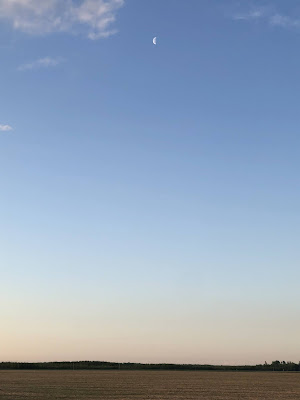Only one percent of the soybeans in this field will become tofu or soy lattes. I wonder if Ed has tried edamame or steamed soybeans, roasted in olive oil and salt. Around half of the crop will be exported. What stays here will be fed to animals, mostly chickens. A lot of it will also be turned into cooking oil and five percent will become biodiesel to haul those soybeans all over.
When I first moved here in 1973, soybeans could not be grown this far north. It was all wheat and barley then with a fair amount of flax for linseed oil. The linseed oil went into paint, but when everyone switched to latex paint, the flax went away, which was too bad, because flax produces a pretty blue flower. Flax is also made into linen, but linen needs are down there with soy lattes.
For a while in the 1980s, sunflowers were the hot crop, grown mainly for the oil. Bird seed was the latte/linen byproduct. Then canola pushed sunflowers out. Canola was the ancient Chinese crop originally known as rape seed, grown for the oil. The Canadians started growing canola before the U.S. Some marketing guy in Toronto said that any product with the word 'rape' in it was going to be a tough sell, so they came up with 'Canola': Canadian oil, get it?
It's soybean's turn now. Thanks to new varieties and a warming climate, soybeans have become the largest crop grown in Roseau County by far. It all about economics. Poor canola is way down and it's rare to see a sunflower field. That's a shame, because sunflowers are beautiful as everyone knows. Soybeans are of no visual interest.
So here's your picture Ed. Soybeans are here to stay. If you put enough sugar or salt on them, they'll be delish.
 |
| Half moon with Half Section of Tofu |
2 comments:
Quinoa will be next.
Not on my watch!
Post a Comment